RENAULT TRAFIC 2017 X82 / 3.G Repair Manual
Manufacturer: RENAULT, Model Year: 2017, Model line: TRAFIC, Model: RENAULT TRAFIC 2017 X82 / 3.GPages: 294, PDF Size: 7.94 MB
Page 61 of 294
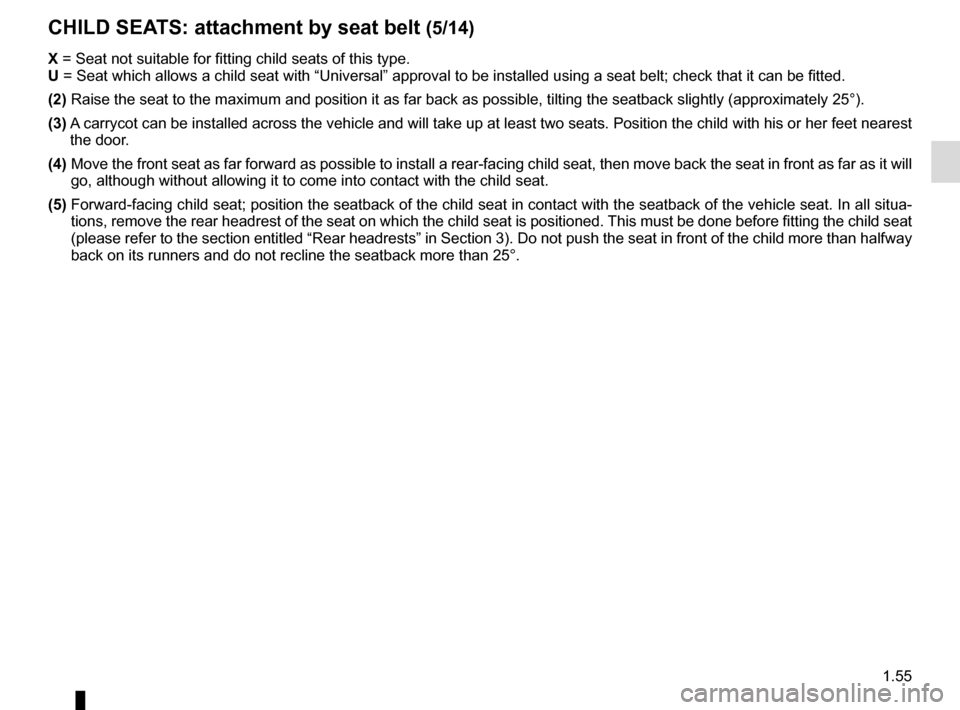
1.55
CHILD SEATS: attachment by seat belt (5/14)
X = Seat not suitable for fitting child seats of this type.
U = Seat which allows a child seat with “Universal” approval to be ins\
talled using a seat belt; check that it can be fitted.
(2) Raise the seat to the maximum and position it as far back as possible, \
tilting the seatback slightly (approximately 25°).
(3) A carrycot can be installed across the vehicle and will take up at least \
two seats. Position the child with his or her feet nea rest
the door.
(4) Move the front seat as far forward as possible to install a rear-facing \
child seat, then move back the seat in front as far as it will
go, although without allowing it to come into contact with the child sea\
t.
(5) Forward-facing child seat; position the seatback of the child seat in co\
ntact with the seatback of the vehicle seat. In all sit ua-
tions, remove the rear headrest of the seat on which the child seat is p\
ositioned. This must be done before fitting the child s eat
(please refer to the section entitled “Rear headrests” in Section\
3). Do not push the seat in front of the child more than half way
back on its runners and do not recline the seatback more than 25°.
Page 62 of 294
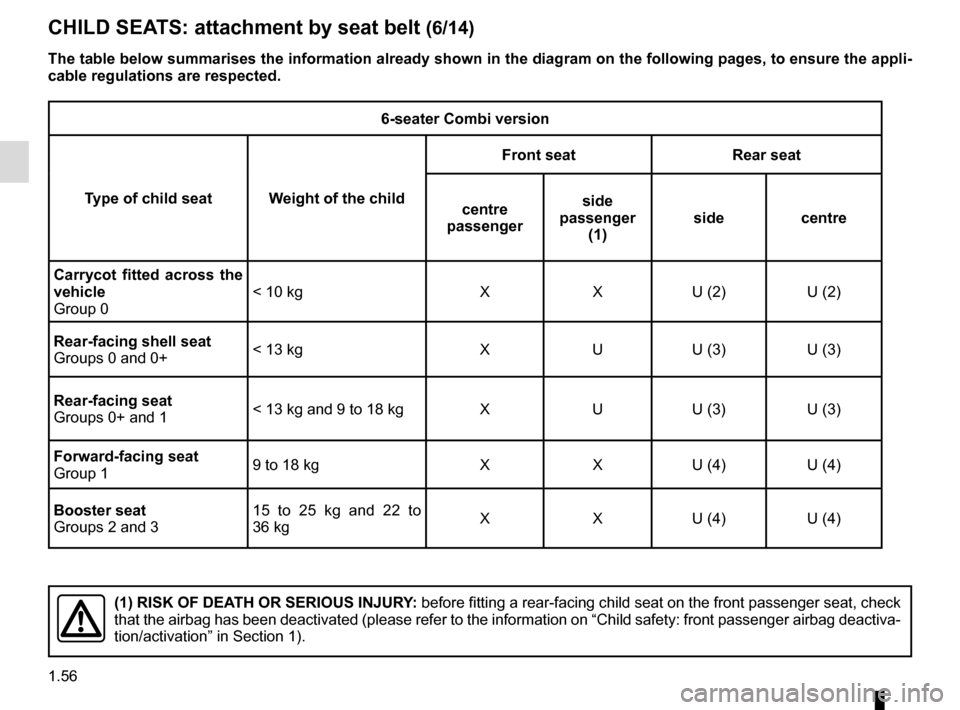
1.56
6-seater Combi version
Type of child seat Weight of the child Front seat Rear seat
centre
passenger side
passenger (1) side centre
Carrycot fitted across the
vehicle
Group 0 < 10 kg X X U (2) U (2)
Rear-facing shell seat
Groups 0 and 0+ < 13 kg X U U (3) U (3)
Rear-facing seat
Groups 0+ and 1 < 13 kg and 9 to 18 kg X U U (3) U (3)
Forward-facing seat
Group 1 9 to 18 kg X X U (4) U (4)
Booster seat
Groups 2 and 3 15 to 25 kg and 22 to
36 kg
X X U (4) U (4)
CHILD SEATS: attachment by seat belt (6/14)
(1) RISK OF DEATH OR SERIOUS INJURY:
before fitting a rear-facing child seat on the front passenger seat, ch\
eck
that the airbag has been deactivated (please refer to the information o\
n “Child safety: front passenger airbag deactiva-
tion/activation” in Section 1).
The table below summarises the information already shown in the diagram \
on the following pages, to ensure the appli-
cable regulations are respected.
Page 63 of 294
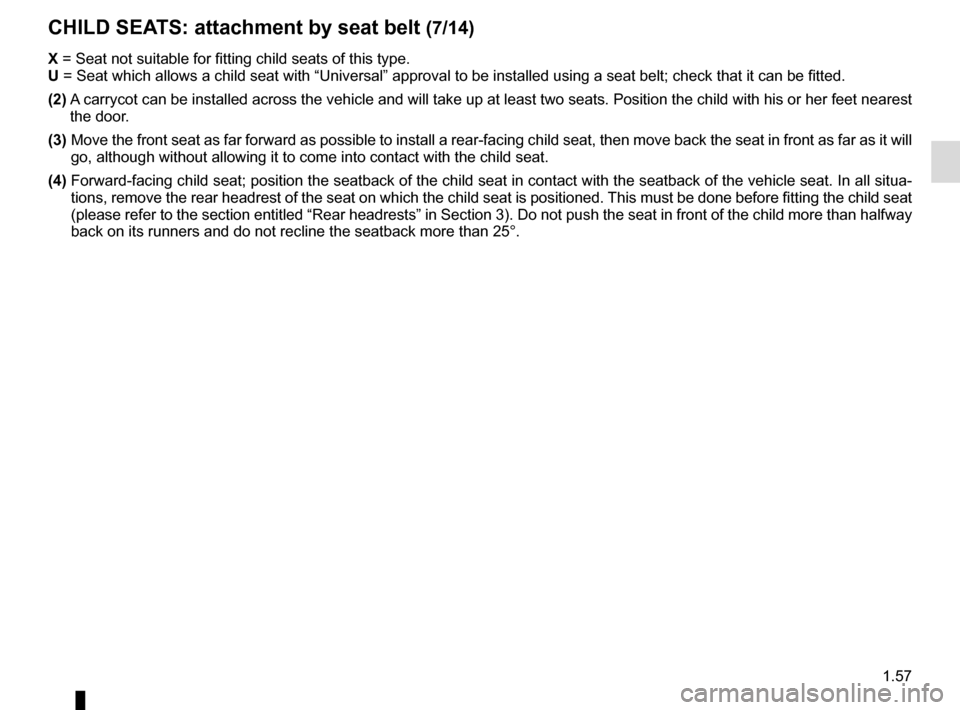
1.57
CHILD SEATS: attachment by seat belt (7/14)
X = Seat not suitable for fitting child seats of this type.
U = Seat which allows a child seat with “Universal” approval to be ins\
talled using a seat belt; check that it can be fitted.
(2) A carrycot can be installed across the vehicle and will take up at least \
two seats. Position the child with his or her feet nea rest
the door.
(3) Move the front seat as far forward as possible to install a rear-facing \
child seat, then move back the seat in front as far as it will
go, although without allowing it to come into contact with the child sea\
t.
(4) Forward-facing child seat; position the seatback of the child seat in co\
ntact with the seatback of the vehicle seat. In all sit ua-
tions, remove the rear headrest of the seat on which the child seat is p\
ositioned. This must be done before fitting the child s eat
(please refer to the section entitled “Rear headrests” in Section\
3). Do not push the seat in front of the child more than half way
back on its runners and do not recline the seatback more than 25°.
Page 64 of 294
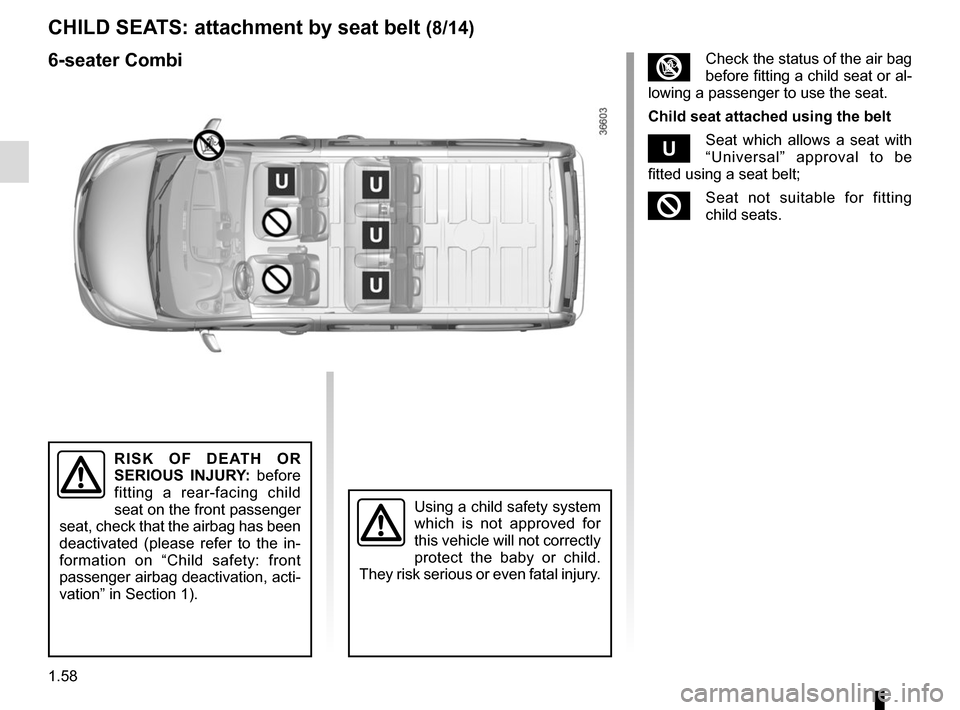
1.58
CHILD SEATS: attachment by seat belt (8/14)
³Check the status of the air bag
before fitting a child seat or al-
lowing a passenger to use the seat.
Child seat attached using the belt
¬Seat which allows a seat with
“Universal” approval to be
fitted using a seat belt;
²Seat not suitable for fitting
child seats.
Using a child safety system
which is not approved for
this vehicle will not correctly
protect the baby or child.
They risk serious or even fatal injury.
RISK OF DEATH OR
SERIOUS INJURY: before
fitting a rear-facing child
seat on the front passenger
seat, check that the airbag has been
deactivated (please refer to the in-
formation on “Child safety: front
passenger airbag deactivation, acti-
vation” in Section 1).
6-seater Combi
Page 65 of 294
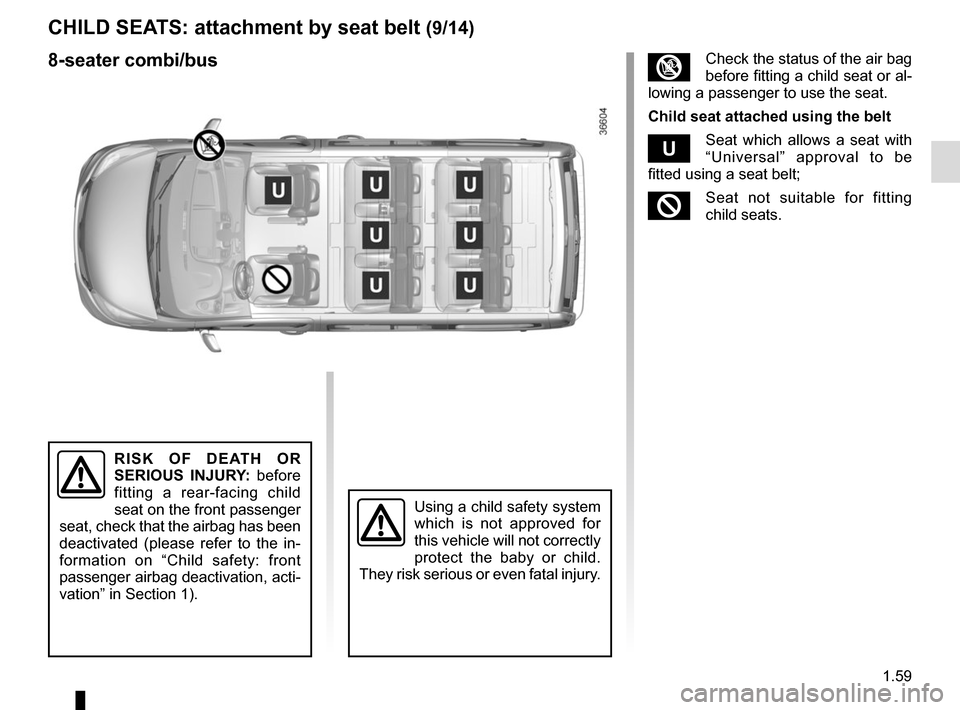
1.59
RISK OF DEATH OR
SERIOUS INJURY: before
fitting a rear-facing child
seat on the front passenger
seat, check that the airbag has been
deactivated (please refer to the in-
formation on “Child safety: front
passenger airbag deactivation, acti-
vation” in Section 1).
³Check the status of the air bag
before fitting a child seat or al-
lowing a passenger to use the seat.
Child seat attached using the belt
¬Seat which allows a seat with
“Universal” approval to be
fitted using a seat belt;
²Seat not suitable for fitting
child seats.
Using a child safety system
which is not approved for
this vehicle will not correctly
protect the baby or child.
They risk serious or even fatal injury.
CHILD SEATS: attachment by seat belt (9/14)
8-seater combi/bus
Page 66 of 294
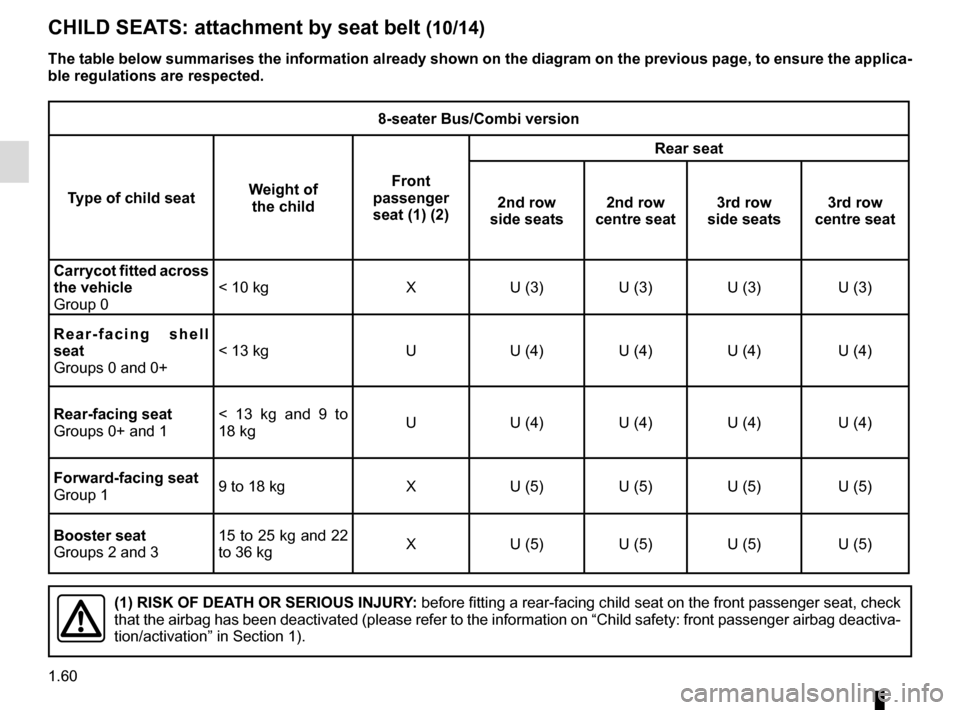
1.60
CHILD SEATS: attachment by seat belt (10/14)
8-seater Bus/Combi version
Type of child seat Weight of
the child Front
passenger seat (1) (2) Rear seat
2nd row
side seats 2nd row
centre seat 3rd row
side seats 3rd row
centre seat
Carrycot fitted across
the vehicle
Group 0 < 10 kg X U (3) U (3) U (3) U (3)
Rear-facing shell
seat
Groups 0 and 0+ < 13 kg U U (4) U (4) U (4) U (4)
Rear-facing seat
Groups 0+ and 1 < 13 kg and 9 to
18 kg
U U (4) U (4) U (4) U (4)
Forward-facing seat
Group 1 9 to 18 kg X U (5) U (5) U (5) U (5)
Booster seat
Groups 2 and 3 15 to 25 kg and 22
to 36 kg
X U (5) U (5) U (5) U (5)
(1) RISK OF DEATH OR SERIOUS INJURY:
before fitting a rear-facing child seat on the front passenger seat, ch\
eck
that the airbag has been deactivated (please refer to the information o\
n “Child safety: front passenger airbag deactiva-
tion/activation” in Section 1).
The table below summarises the information already shown on the diagram \
on the previous page, to ensure the applica-
ble regulations are respected.
Page 67 of 294
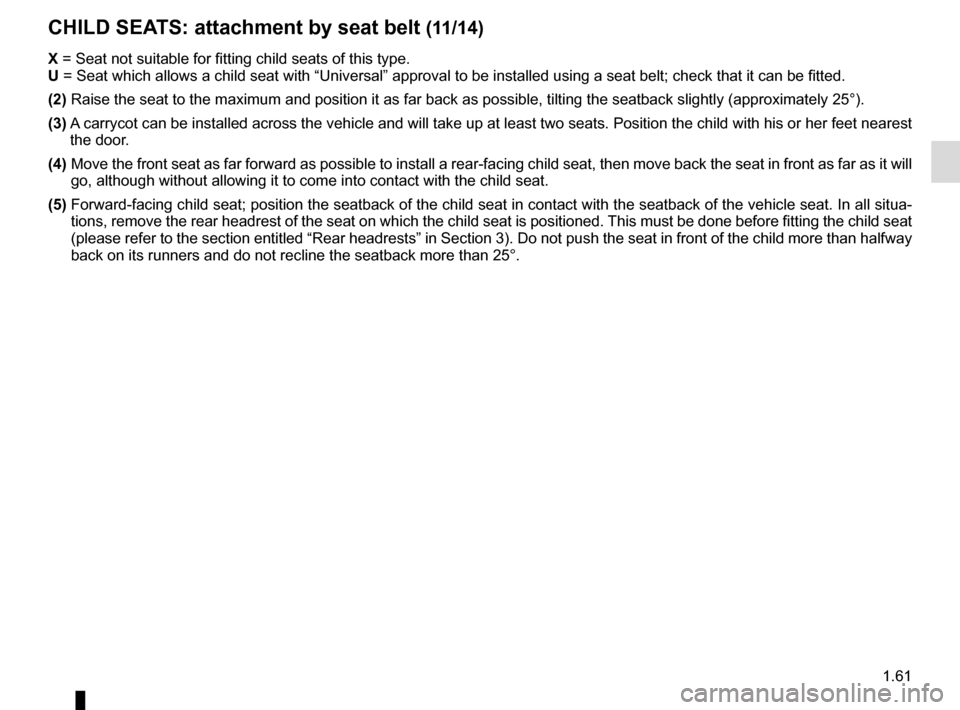
1.61
CHILD SEATS: attachment by seat belt (11/14)
X = Seat not suitable for fitting child seats of this type.
U = Seat which allows a child seat with “Universal” approval to be ins\
talled using a seat belt; check that it can be fitted.
(2) Raise the seat to the maximum and position it as far back as possible, \
tilting the seatback slightly (approximately 25°).
(3) A carrycot can be installed across the vehicle and will take up at least \
two seats. Position the child with his or her feet nea rest
the door.
(4) Move the front seat as far forward as possible to install a rear-facing \
child seat, then move back the seat in front as far as it will
go, although without allowing it to come into contact with the child sea\
t.
(5) Forward-facing child seat; position the seatback of the child seat in co\
ntact with the seatback of the vehicle seat. In all sit ua-
tions, remove the rear headrest of the seat on which the child seat is p\
ositioned. This must be done before fitting the child s eat
(please refer to the section entitled “Rear headrests” in Section\
3). Do not push the seat in front of the child more than half way
back on its runners and do not recline the seatback more than 25°.
Page 68 of 294
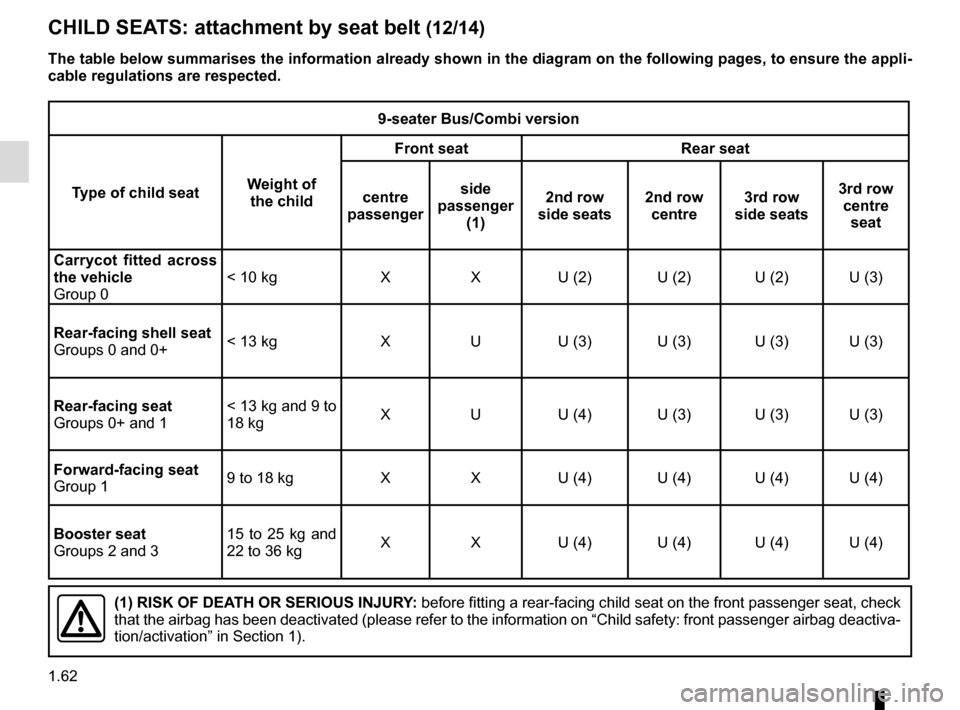
1.62
CHILD SEATS: attachment by seat belt (12/14)
9-seater Bus/Combi version
Type of child seat Weight of
the child Front seat Rear seat
centre
passenger side
passenger (1) 2nd row
side seats 2nd row
centre 3rd row
side seats 3rd row
centre seat
Carrycot fitted across
the vehicle
Group 0 < 10 kg X X U (2) U (2) U (2) U (3)
Rear-facing shell seat
Groups 0 and 0+ < 13 kg X U U (3) U (3) U (3) U (3)
Rear-facing seat
Groups 0+ and 1 < 13 kg and 9 to
18 kg
X U U (4) U (3) U (3) U (3)
Forward-facing seat
Group 1 9 to 18 kg X X U (4) U (4) U (4) U (4)
Booster seat
Groups 2 and 3 15 to 25 kg and
22 to 36 kg
X X U (4) U (4) U (4) U (4)
(1) RISK OF DEATH OR SERIOUS INJURY:
before fitting a rear-facing child seat on the front passenger seat, ch\
eck
that the airbag has been deactivated (please refer to the information o\
n “Child safety: front passenger airbag deactiva-
tion/activation” in Section 1).
The table below summarises the information already shown in the diagram \
on the following pages, to ensure the appli-
cable regulations are respected.
Page 69 of 294
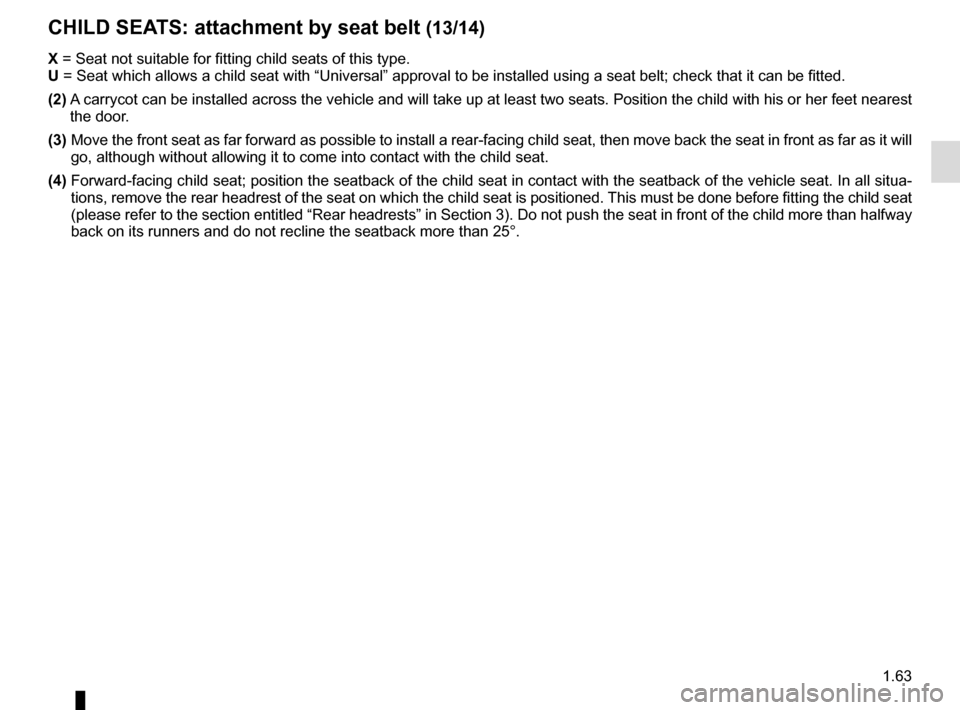
1.63
CHILD SEATS: attachment by seat belt (13/14)
X = Seat not suitable for fitting child seats of this type.
U = Seat which allows a child seat with “Universal” approval to be ins\
talled using a seat belt; check that it can be fitted.
(2) A carrycot can be installed across the vehicle and will take up at least \
two seats. Position the child with his or her feet nea rest
the door.
(3) Move the front seat as far forward as possible to install a rear-facing \
child seat, then move back the seat in front as far as it will
go, although without allowing it to come into contact with the child sea\
t.
(4) Forward-facing child seat; position the seatback of the child seat in co\
ntact with the seatback of the vehicle seat. In all sit ua-
tions, remove the rear headrest of the seat on which the child seat is p\
ositioned. This must be done before fitting the child s eat
(please refer to the section entitled “Rear headrests” in Section\
3). Do not push the seat in front of the child more than half way
back on its runners and do not recline the seatback more than 25°.
Page 70 of 294
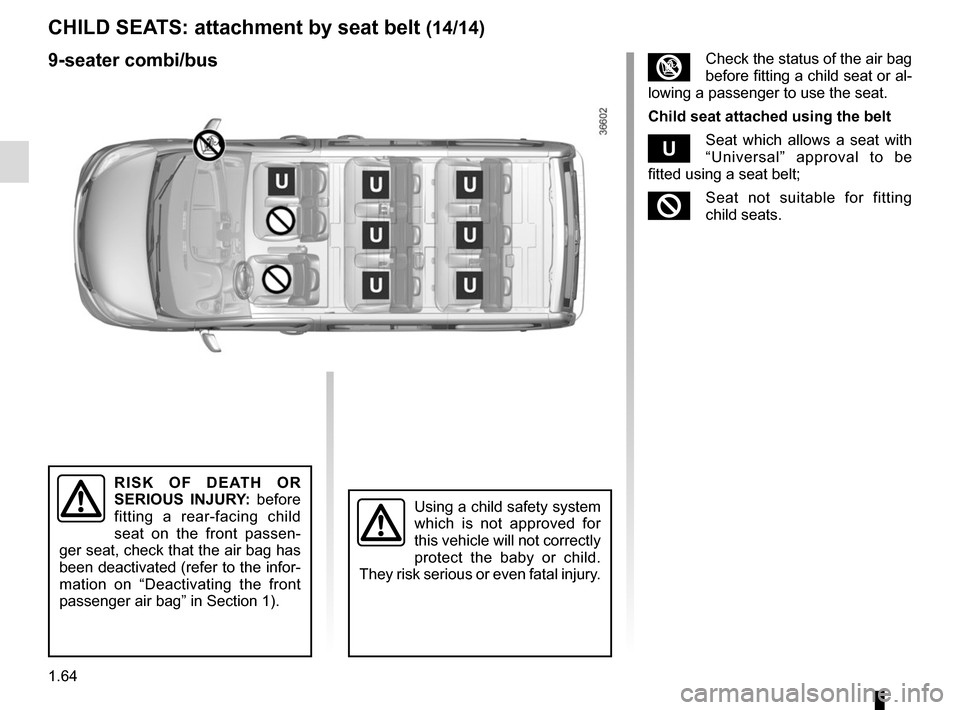
1.64
RISK OF DEATH OR
SERIOUS INJURY: before
fitting a rear-facing child
seat on the front passen-
ger seat, check that the air bag has
been deactivated (refer to the infor-
mation on “Deactivating the front
passenger air bag” in Section 1).
³Check the status of the air bag
before fitting a child seat or al-
lowing a passenger to use the seat.
Child seat attached using the belt
¬Seat which allows a seat with
“Universal” approval to be
fitted using a seat belt;
²Seat not suitable for fitting
child seats.
Using a child safety system
which is not approved for
this vehicle will not correctly
protect the baby or child.
They risk serious or even fatal injury.
CHILD SEATS: attachment by seat belt (14/14)
9-seater combi/bus